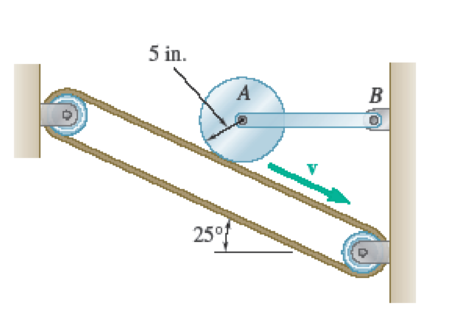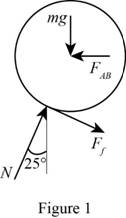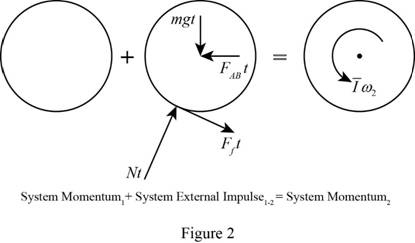
Concept explainers
A uniform disk, initially at rest and of constant thickness, is placed in contact with the belt shown, which moves at a constant speed v = 80 ft/s. Knowing that the coefficient of kinetic friction between the disk and the belt is 0.15, determine (a) the number of revolutions executed by the disk before it reaches a constant angular velocity, (b) the time required for the disk to reach that constant angular velocity.

Fig. P17.135
(a)
Find the number of revolutions executed by the disk before it reaches a constant angular velocity.
Answer to Problem 17.135RP
The number of revolutions executed by the disk is
Explanation of Solution
Given information:
The speed of the belt is
The coefficient of kinetic friction between the disk and the belt is
The radius of the uniform disk is
Calculation:
Show the free-body diagram of the disk as in Figure 1.

Find the frictional force
Here, the normal force is N.
Substitute 0.15 for
Resolve the vertical component of forces to find the normal force.
Here, the mass of the disk is m and the acceleration due to gravity is g.
Consider the acceleration due to gravity as
Substitute 0.15N for
Substitute
Find the mass moment of inertia
Here, the radius of the disk is r.
Find the angular velocity
Find the work done
Here, the number of revolutions is
Substitute
The total kinetic energy at initial position is zero.
Find the total kinetic energy after reaching the constant angular velocity using the relation.
Substitute
Write the equation of conservation of energy and work as follows;
Substitute 0 for
Substitute 5 in. for r,
Therefore, the number of revolutions executed by the disk is
(b)
Find the time required for the disk to reach the constant angular velocity.
Answer to Problem 17.135RP
The time required for the disk is
Explanation of Solution
Given information:
The speed of the belt is
The coefficient of kinetic friction between the disk and the belt is
The radius of the uniform disk is
Calculation:
Show the free-body diagram of the principle of impulse-momentum as in Figure 2.

Take moment about point A as follows;
Substitute
Substitute
Therefore, the time required for the disk is
Want to see more full solutions like this?
Chapter 17 Solutions
Vector Mechanics for Engineers: Statics and Dynamics
Additional Engineering Textbook Solutions
Fluid Mechanics: Fundamentals and Applications
Introduction To Finite Element Analysis And Design
Foundations of Materials Science and Engineering
Vector Mechanics for Engineers: Statics, 11th Edition
Heating Ventilating and Air Conditioning: Analysis and Design
HEAT+MASS TRANSFER:FUND.+APPL.
- A long ladder of length l, mass m, and centroidal mass moment of inertia I is placed against a house at an angle 0=0O. Knowing that the ladder is released from rest, determine the angular velocity of the ladder when 0=02. Assume the ladder can slide freely on the horizontal ground and on the vertical wall.arrow_forwardDisk A, of weight 5 lb and radius r = 3 in., is at rest when it is placed in contact with a belt that moves at a constant speed v = 50 ft/s. Knowing that μk = 0.20 between the disk and the belt, determine the time required for the disk to reach a constant angular velocity.arrow_forwardDisk A, of weight 10 lb and radius r = 6 in., is at rest when it is placed in contact with belt BC, which moves to the right with a constant speed v = 40 ft/s. Knowing that μk = 0.20 between the disk and the belt, determine the number of revolutions executed by the disk before it attains a constant angular velocity.arrow_forward
- The rotor of an electric motor has an angular velocity of 3600 rpm when the load and power are cut off. The 110-lb rotor, which has a centroidal radius of gyration of 9 in., then coasts to rest. Knowing that the kinetic friction of the rotor produces a couple with a magnitude of 2.5 1b.ft determine the number of revolutions that the rotor executes before coming to rest.arrow_forwardThe rotor of an electric motor has an angular velocity of 3570 rpm when the load and power are cut off. The 65-kg rotor, which has a centroidal radius of gyration of 175mm, until it reaches the maximum speed of 5250 rpm. Knowing that the kinetic friction results in a couple of magnitude 4.5 N.m exerted on the rotor, determine the number of revolutions that the rotor executes, before achieving its maximum speed and the time it took. (The final answer should be in two decimal places with correct units)arrow_forwardThe rotor of an electric motor has an angular velocity of 3600 rpm when the load and power are cut off. The 120-lb rotor, which has a centroidal radius of gyration of 9 in., then coasts to rest. Knowing that kinetic friction results in a couple of magnitude 2.5 lb·ft exerted on the rotor, determine the number of revolutions that the rotor executes before coming to rest.arrow_forward
- A cylinder of radius r and weight W with an initial counterclockwise angular velocity w0 is placed in the corner formed by the floor and a vertical wall. Denoting by μk the coefficient of kinetic friction between the cylinder and the wall and the floor, derive an expression for the time required for the cylinder to come to rest.arrow_forwardThe 80-mm-radius gear shown has a mass of 5 kg and a centroidal radius of gyration of 60 mm. The 4-kg rod AB is attached to the center of the gear and to a pin at B that slides freely in a vertical slot. Knowing that the system is released from rest when 0 = 60°, determine the velocity of the center of the gear when 0 = 20°.arrow_forwardA uniform 144-lb cube is attached to a uniform 136-lb circular shaft as shown, and a couple M with a constant magnitude is applied to the shaft when the system is at rest. Knowing that r = 4 in., L= 12 in., and the angular velocity of the system is 960 rpm after 4 s, determine the magnitude of the couple M.arrow_forward
- The 10-in.-radius brake drum is attached to a larger flywheel which is not shown. The total mass moment of inertia of the flywheel and drum is 22 lb ⋅ ft ⋅ s 2 and the coefficient of kinetic friction between the drum and the brake shoe is 0.41. Knowing that the initial angular velocity is 255 rpm clockwise, determine the force which must be exerted by the hydraulic cylinder at point B if the system is to stop in 85 revolutions. DO NOT ROUND OFF IN THE SOLUTION. ROUND OFF ONLY THE FINAL ANSWERarrow_forwardThe rotor of an electric motor has an angular velocity of 4500 rpm when the load and power are cut off. The 75-kg rotor, which has a centroidal radius of gyration of 200 mm, then coasts to rest. Knowing that kinetic friction results in a couple of magnitude 4.5 Nm. exerted on the rotor, determine the number of revolutions that the rotor executes before coming to rest.arrow_forwardThe mechanism shown is one of two identical mechanisms attached to the two sides of a 200-lb uniform rectangular door. Edge ABC of the door is guided by wheels of negligible mass that roll in horizontal and vertical tracks. A spring with a constant of k = 40 lb/ft is attached to wheel B. Knowing that the door is released from rest in the position 0= 30° with the spring unstretched, determine the velocity of wheel A just as the door reaches the vertical position.arrow_forward
 Elements Of ElectromagneticsMechanical EngineeringISBN:9780190698614Author:Sadiku, Matthew N. O.Publisher:Oxford University Press
Elements Of ElectromagneticsMechanical EngineeringISBN:9780190698614Author:Sadiku, Matthew N. O.Publisher:Oxford University Press Mechanics of Materials (10th Edition)Mechanical EngineeringISBN:9780134319650Author:Russell C. HibbelerPublisher:PEARSON
Mechanics of Materials (10th Edition)Mechanical EngineeringISBN:9780134319650Author:Russell C. HibbelerPublisher:PEARSON Thermodynamics: An Engineering ApproachMechanical EngineeringISBN:9781259822674Author:Yunus A. Cengel Dr., Michael A. BolesPublisher:McGraw-Hill Education
Thermodynamics: An Engineering ApproachMechanical EngineeringISBN:9781259822674Author:Yunus A. Cengel Dr., Michael A. BolesPublisher:McGraw-Hill Education Control Systems EngineeringMechanical EngineeringISBN:9781118170519Author:Norman S. NisePublisher:WILEY
Control Systems EngineeringMechanical EngineeringISBN:9781118170519Author:Norman S. NisePublisher:WILEY Mechanics of Materials (MindTap Course List)Mechanical EngineeringISBN:9781337093347Author:Barry J. Goodno, James M. GerePublisher:Cengage Learning
Mechanics of Materials (MindTap Course List)Mechanical EngineeringISBN:9781337093347Author:Barry J. Goodno, James M. GerePublisher:Cengage Learning Engineering Mechanics: StaticsMechanical EngineeringISBN:9781118807330Author:James L. Meriam, L. G. Kraige, J. N. BoltonPublisher:WILEY
Engineering Mechanics: StaticsMechanical EngineeringISBN:9781118807330Author:James L. Meriam, L. G. Kraige, J. N. BoltonPublisher:WILEY





